There are 25 salamanders in Louisiana and are under six families which are Ambystomatidae, Amphiumidae, Plethodontidae, Proteidae, Salamandridae, and Sirenidae.
Mole salamanders make up Ambystomatidae and include species such as the marbled and tiger salamanders.
Amphiumas make up Amphiumidae. Amphiumas are eel-like salamanders with four tiny limbs. There are two amphiumas in Louisiana.
Lungless salamanders make up Plethodontidae. These are salamanders that lack lungs. They respire through their skin and mouth.
Mudpuppies and waterdogs make up Proteidae. The Gulf Coast waterdog and the mudpuppy are both endemic to the state.
Newts make up Salamandridae. The eastern newt is the only newt endemic to the state.
Sirens make up Sirenidae. The lesser siren is endemic to the state.
Table of Contents
Salamanders in Louisiana
Family Ambystomatidae
1. Spotted Salamander
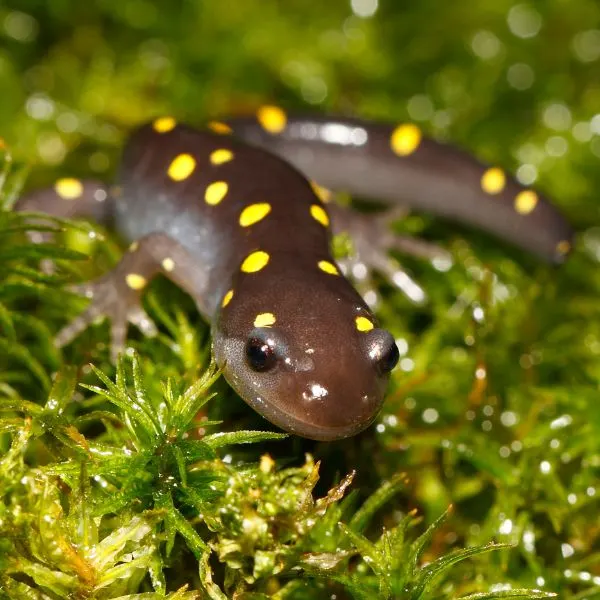
- Binomial nomenclature: Ambystoma maculatum
- Adult Size: 6 to 8 inches (15.24 to 20.32 cm)
- Lifespan: 5 years average in captivity
- Conservation Status: S5
- Distribution in Louisiana: Statewide
The color of an adult spotted salamander is dark gray, dark brown, or black with large orange or yellow spots. The larvae are dull olive green and about 12 to 17 mm long.
The species is endemic to southeastern Canada and most of the eastern United States. The range extends as far west as east Texas and eastern Iowa.
This amphibian inhabits mixed forest and hardwood forests. Ambystoma maculatum is always close to swamps or vernal pools within this habitat. They are difficult to spot even within their microhabitat as they mostly remain hidden under soil covers such as stumps and logs or underground in burrows.
The species lay eggs on submerged objects in vernal and permanent pools close to or in forests.
Adult spotted salamanders are most active at night during the breeding period after/during rains.
Ambystoma maculatum is carnivorous, specifically invertivores. They feed on terrestrial invertebrates as adults and aquatic invertebrates as larvae.
2. Marbled Salamander
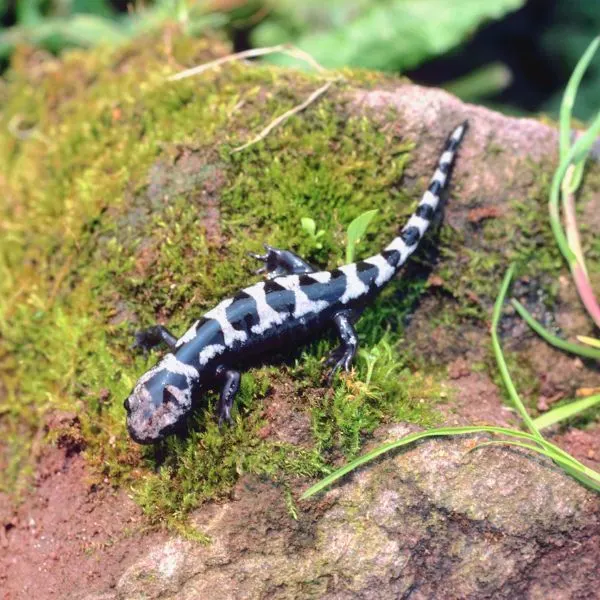
- Scientific Name: Ambystoma opacum
- Average Adult Size: 3.5 to 4.25 inches (9 to 10.7 cm)
- Lifespan: up to 8 years
- Conservation Status: S5
- Distribution in Louisiana: Statewide
The species acquires its common name from its appearance. The background color is black. However, the marbled salamander has silvery white (adult males) or silvery gray (adult females) crossbands.
The species is endemic to the eastern United States. The range extends as far north as southern New Hampshire and as far south as northern Florida. The range stretches from New York to southern Lake Michigan and south to the Gulf Coast.
Ambystoma opacum inhabits wooded habitats adjacent to vernal pools and swamps. Unlike most salamanders, Ambystoma opacum can inhabit dry habitats. As such, they can be spotted on wooded sand dunes and rocky bluffs.
Larvae live in vernal pools and other freshwaters (including streams, swamps, and permanent ponds) in which gravid females nest. Adults are terrestrial. They also are generally hidden.
Adults feed exclusively on terrestrial invertebrates and larvae fed on amphibian larvae and aquatic invertebrates.
3. Mole Salamander
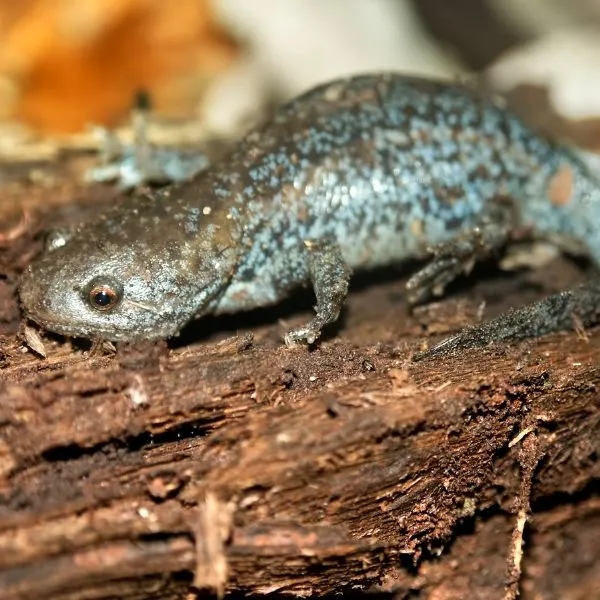
- Scientific Name: Ambystoma talpoideum
- Average Adult Size: 3 to 4 inches (7.5 to 10 cm)
- Lifespan: 10 to 20 years
- Conservation Status: S5
- Distribution in Louisiana: Statewide
The mole salamander may undergo metamorphism and grow into terrestrial form as adults or never undergo paedomorphism and retain their aquatic larval form as adults. As terrestrial adults, they are black to gray with whitish flecks on the back and tail. Aquatic neotenic adults display yellow stripes on their ventrum which is easy to identify.
The species is endemic statewide in Louisiana. Outside of the state, the species is endemic to Coastal Plains from South Carolina to northern Florida and then westward to southeastern Oklahoma and eastern Texas; northward to southern Indiana, and southern Illinois to Mississippi Valley.
The species inhabits bottomland hardwood forests, floodplains, and pine flatwood. Within these habitats, the species live close to breeding ponds. Adults are terrestrial but usually hide under logs and other objects in places of high humidity/moisture and even in underground burrows.
The breeding habitats of Ambystoma talpoideum are flooded depressions and shallow ponds that have abundant vegetation and no predatory fish.
In Louisiana, the annual survival rate of adults was 64 to 84 percent.
4. Small-Mouthed Salamander
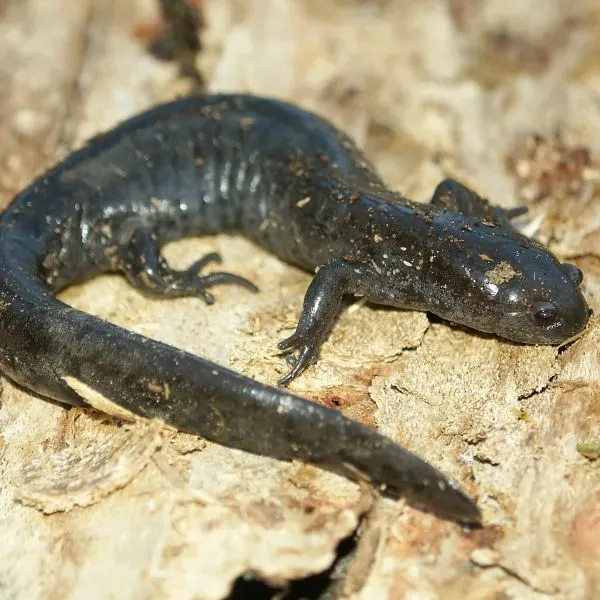
- Binomial Nomenclature: Ambystoma texanum
- Adult Length: 4.3 to 7 inches (11 to 17.8 cm)
- Lifespan: 5.3 years in captivity
- Conservation Status: S5
- Distribution in Louisiana: Statewide
Ambystoma texanum gets its name from its small head and short snout. The dorsum/upper body is black to gray with light markings which darken on the sides and the ventrum/underside. The underside is dark in color as well.
Ambystoma texanum is endemic to eastern North America as far east as western West Virginia. The range of the species extends northward to Pelee Island of southwestern Ontario and southern Michigan. Westward, the range extends to eastern Texas, eastern Kansas, and southern Iowa. The species is regarded as secure within Louisiana.
The species is endemic to woodlands, forests, and grasslands. They live in dense hardwood forests, oak woodlands, floodplain forests, moist pine woodland, and tallgrass prairie. The terrestrial adult is often hidden. They hide underground in burrows, under logs, leaf litter, and rocks.
In Louisiana, the species breed from December to February.
5. Eastern Tiger Salamander
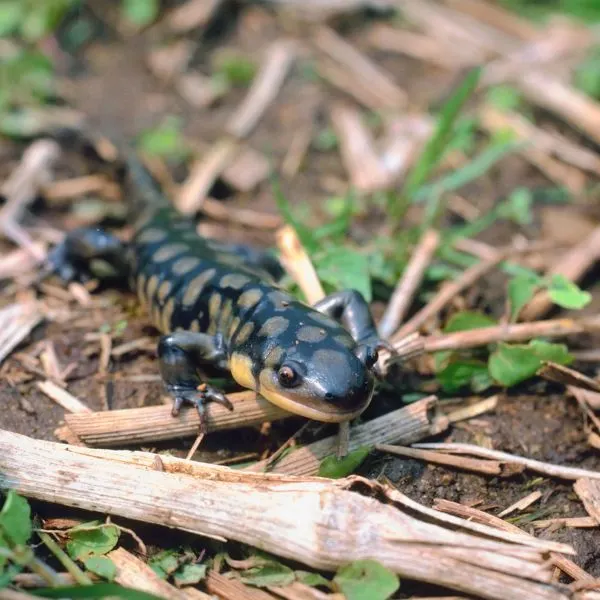
- Binomial Nomenclature: Ambystoma tigrinum
- Adult Length: 7 to 13 inches (17 to 33 cm)
- Lifespan: 16 to 25 years
- Conservation Status: S1
- Distribution in Louisiana: South
The tiger salamander gets its common name from its coloration which is a black with yellowish markings which can be blotches, spots, or stripes.
Within Louisiana, the species is endemic to the south. The species’ range extends as far north as southeastern Manitoba in Canada. Southward, the range extends to East Texas and Southern Louisiana. The species occurs throughout most of eastern North America. It is, however, mostly absent from the Appalachian mountains and New England.
Ambystoma tigrinum occurs in most habitats as far as the ground is suitable for burrowing and the habitat is close to a freshwater cody suitable for breeding. Similar to other mole salamanders, Ambystoma tigrinum usually remain hidden for most of the year. Here it hides underground in burrows other animals such as shrews and rodents dug or it dug up themselves.
Family Amphiumidae
6. Two-toed Amphiuma

- Scientific Name: Amphiuma means
- Average Adult Size: 14.5 to 46 inches (36.8 to 117 cm)
- Lifespan: 27 years
- Conservation Status: S3S4
- Distribution in Louisiana: East
The two-toed amphiuma is long and cylindrical. They are black to dark brown with dark gray undersides. They have four tiny legs and two toes on each foot.
The two-toed amphiuma is endemic to the Coastal Plain from eastern Louisiana and Florida to southeastern Virginia. Within Louisiana, the species is considered ‘Vulnerable’.
The two-toed amphiuma is entirely aquatic although it leaves water sometimes, especially on rainy nights. The two-toed amphiuma live in meddy lakes, wet meadows, slow-moving streams, drainage ditches, cypress heads, the margins of muddy sloughs, bayous, and swamps.
Amphiuma means feeds on small reptiles and amphibians, fishes, worms, mollusks, crayfish and insects found in shallow waters. The species feed in shallow water.
7. Three-toed Amphiuma
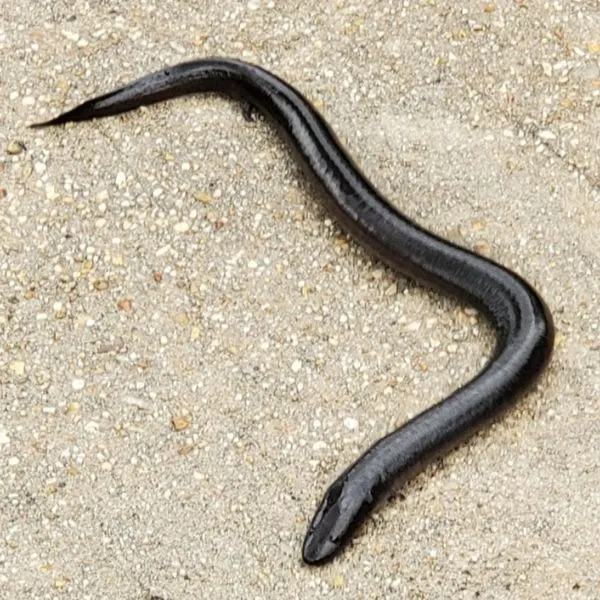
- Binomial Nomenclature: Amphiuma tridactylum
- Average Adult Size: 18 to 30 inches (46 to 76 cm)
- Lifespan: 27 years
- Conservation Status: S5
- Distribution in Louisiana: Statewide
The three-toed amphiuma is similar in appearance to the two-toed amphiuma except that the three-toed amphiuma has three toes on each foot. The dorsum is dark and the underside is light in color. It is long and cylindrical. The three-toed amphiuma has the appearance of an eel.
The species is endemic to the extreme east texas through the entirety of Louisiana, most of Mississippi to western Alabama; the range extends northward to eastern tennessee to southeastern missouri and Kentucky; the species is also endemic to southeastern Oklahoma and eastern Arkansas.
The three-toed amphiuma is permanently aquatic and has a free-living larval stage. The species is endemic to swampy banks of cypress sloughs & bayous, seepy pools, lakes & marshes in flood lands, ca;careous streams, and wooded alluvial swamps.
Unlike most salamanders, Amphiuma tridactylum can inhabit water bodies with a large population of fish.
Family Plethodontidae
8. Holbrook’s Southern Dusky Salamander

- Scientific Name: Desmognathus auriculatus
- Adult Length: 3 to 6 inches
- Conservation Status: S1
- Distribution in Louisiana: West, Southeast
The Holbrook’s southern dusky salamander is black or dark brown in color. Its tail is long and its hind limbs are much larger than its front limbs.
Desmognathus auriculatus is endemic to the Coastal Plain from eastern Texas and Florida to southeastern Virginia. Within Louisiana, the species is considered ‘Vulnerable’.
Desmognathus auriculatus inhabits acidic environments. It occurs in floodplain pools, mud-bottomed streams, cypress heads, swamps, springs, and ravine streams. The species is usually close to or in flowing water. Similar to other semi-terrestrial salamanders, Desmognathus auriculatus remains hidden under debris, logs, and leaves or in burrows throughout the day. This behavior makes them difficult to spot.
Desmognathus auriculatus is an opportunistic invertivore and feeds on worms, arthropods, and other invertebrates.
9. Spotted Dusky Salamander
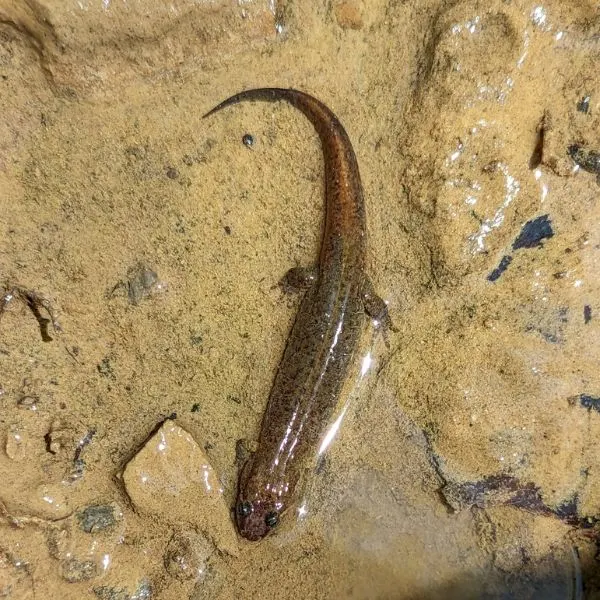
- Scientific Name: Desmognathus conanti
- Adult Length: 2.5 to 5 inches (6.4 to 12.7 cm)
- Conservation Status: S5
- Distribution in Louisiana: Statewide
This dusky is gray to brown with about six to eight golden blotches on its upper body. The underside is light in color.
The species is endemic to most of Louisiana. Its range extends west to east Texas and east to Georgia and South Carolina. Northward, the range extends to far western Virginia, eastern Tennessee, and southwestern Kentucky. The species may also be endemic to Illinois although that is to be confirmed.
Desmognathus conanti is an opportunistic feeder and feeds on small invertebrates available within its habitat. As a terrestrial adult, Desmognathus conanti mostly feed on terrestrial insects.
Desmognathus conanti is endemic to mucky sites along upland streams, sloughs, and floodplains. Larvae are generally aquatic. Adults hide under soil surface objects or in burrows adjacent/close to freshwater.
10. Southern Two-lined Salamander
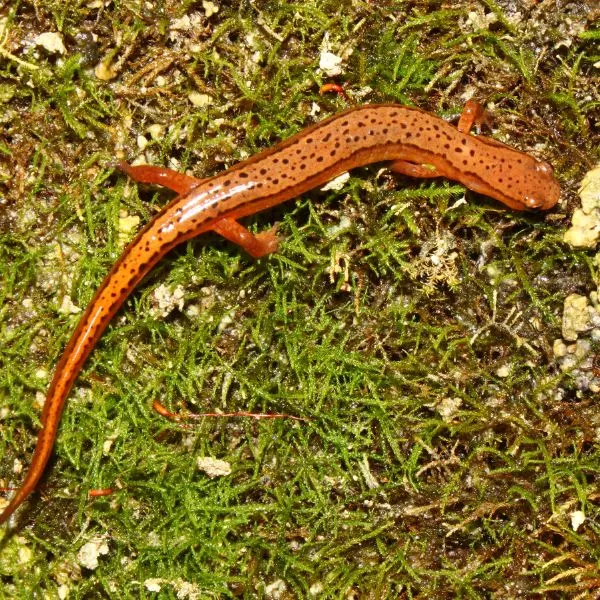
- Scientific Name: Eurycea cirrigera
- Adult Length: 2.6 to 4.7 inches (6.5 to 12 cm)
- Conservation Status: S4
- Distribution in Louisiana: Southeast
Eurycea cirrigera has two stripes down its back from the eyes to the tip of the tail. These stripes give the amphibian its common name.
In Louisiana, the species occurs in the southeast. Outside of Louisiana, the species also occurs in southern Mississippi, southern Alabama, northern Florida to central Virginia, western West Virginia, southern Ohio, Indiana, and Illinois.
The species is endemic to floodplains, river swamps such as tupelo-cypress, seepages, springs, and rocky brooks. During rainy weather, they may be found in wooded terrestrial habitats. They can also be seen crossing roads during rainy weather (during breeding months).
Eurycea cirrigera is an opportunistic feeder and feeds on small invertebrates available within its habitat. As a terrestrial adult, Eurycea cirrigera mostly feeds on terrestrial insects.
11. Three-lined Salamander

- Scientific Name: Eurycea guttolineata
- Average Adult Size: 4 to 6.25 inches (10 to 15.9 cm)
- Conservation Status: S4
- Distribution in Louisiana: Eastern
The three lined salamander has three stripes on its upper body. Two stripes are on the sides and one is down the middle from the eyes to the tail. The background color is light yellow or tan.
The species is endemic to eastern Louisiana, and western Florida. The range extends eastward to Virginia and north to southern Kentucky. The range includes North Carolina, South Carolina, Mississippi, Alama, Georgia, Tennessee, Virginia, Louisiana, and Florida.
The species is endemic to forest floodplains, seepage springs, damp streamsides, and ditches. During rainy weather, they may be found in wooded terrestrial habitats. Similar to other Plethodontid salamanders, the species hide under logs, rocks, and other debris as well as in crayfish burrows, and rock crevices.
Eurycea guttolineata is invertivores. This means that they feed mostly on invertebrates, to be precise small invertebrates
12. Western Dwarf Salamander

- Binomial Nomenclature: Eurycea paludicola
- Conservation Status: SNR
- Distribution in Louisiana: Statewide
Eurycea paludicola is a long and slender salamander. It is tiny like other dwarf salamanders. The background color is bronze with black and gray flecks on the sides. It has four toes on all four feet.
Eurycea paludicola was formerly thought to be a subspecies of E. quadridigitata, described as Manculus quadridigitatus paludicolus. With the use of molecular phylogenetic analysis, Eurycea paludicola was determined to be a separate western lineage within the E. quadridigitata complex. In 2017, Eurycea paludicola was defined as a species.
The species range extends as far west as eastern texas. From there, the range extends through Loiusana and covers most of the state. The range further extends into southern Mississippi as well as southern Arkansas.
The species is endemic to ravine and steephead systems. The species is generally close to breeding habitats in the floodplains of major rivers and creeks. Adults generally inhabit leaf packs atop deep organic muck found along slopes that are above creeks or in seepage among mats of sphagnum.
13. Southern Dwarf Salamander

- Scientific Name: Eurycea quadridigitata
- Adult Length: 2 to 3.5 inches (5 to 8.8 cm)
- Conservation Status: S5
- Distribution in Louisiana: Statewide
This is a tiny salamander with a long tail and a slender body. The species’ dorsum is yellowish-brown with dark brown markings.
The species is endemic to the Coastal Plain. The range extends from eastern Texas to Lake Okeechobee in Florida to North Carolina. Its range used to be bigger since the species Eurycea chamberlaini was considered a yellow morph population of Eurycea quadridigitata.
The species is endemic to bottomland forests, the margins of pine savanna ponds, and low swampy areas. Adults generally remain hidden under logs and other debris and are difficult to spot especially during the day.
The species use seepage areas and shallow ponds as breeding sites.
Some important prey to Eurycea quadridigitata x include springtails, spiders, mites, and ants.
14. Four-toed Salamander
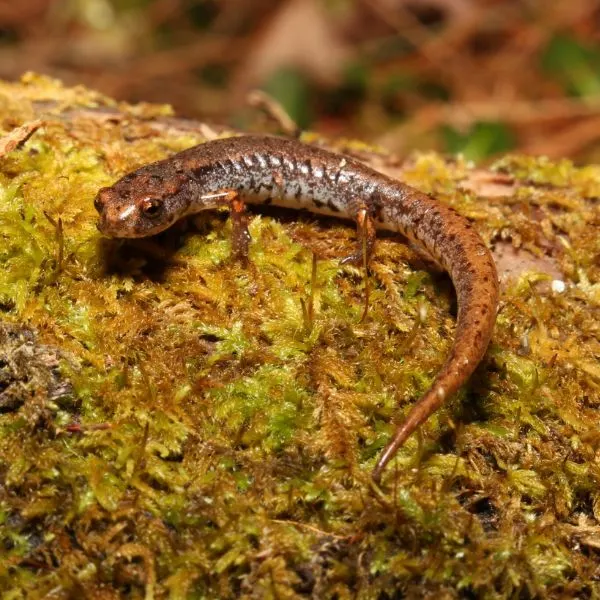
- Binomial nomenclature: Hemidactylium scutatum
- Adult Size: 2 to 3.5 inches (5.08 to 8.89 cm)
- Lifespan: 5.5 years
- Conservation Status: S1
- Distribution in Louisiana: Southeast
The species has four toes on all its feet including its hind feet. Most other salamanders have five toes on their hind feet.. The dorsum is brown and the sides are gray. The sides may have several bluish or black speckles.
The species is endemic to most of eastern North America. Within Canada, the species is endemic to southern Ontario, southern Quebec, New Brunswick, and Nova Scotia. Within the United States, the species is endemic from Maine south to Louisiana and west to Minnesota.
As adults, the species is endemic to open or wet, wooded areas around ponds, boggy streams, and swamps. Here they are generally hidden under objects/debris during most of the day. They commonly inhabit sphagnum moss. The larvae inhabit grassy, mossy, or sedgy pools.
Larvae feed on small aquatic invertebrates and adults feed on small terrestrial invertebrates.
15. Louisiana Slimy Salamander
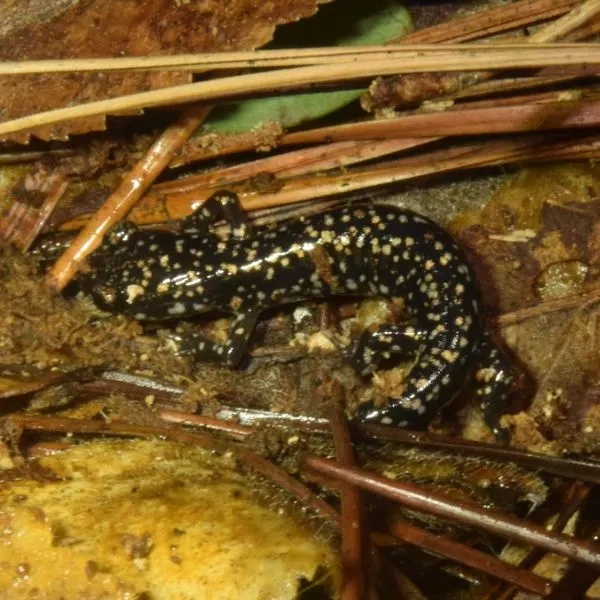
- Binomial Nomenclatures: Plethodon kisatchie
- Conservation Status: S1
- Distribution in Louisiana: Northern half
The species is endemic to the northern half of Louisiana. It is also endemic to southern Arkansas. It is found between elevations of 30 to 400m above sea level.
Plethodon kisatchie has no aquatic stage, unlike most other lungless salamanders. The salamander is generally found in hardwood forests. They are generally under leaf litter, logs, and other covers or in burros, holes, and crevices. The females lay eggs under logs.
Both the immature and adult Louisiana slimy salamanders are invertivores and feed on small terrestrial invertebrates.
16. Mississippi Slimy Salamander

- Scientific Name: Plethodon mississippi
- Adult Length: 4.7 inches (12 cm)
- Conservation Status: SNR
- Distribution in Louisiana: Southeast
The Mississippi slimy salamander has a black background with bronze, silver ot white spots.
Within Louisiana, the species is endemic to the Parishes of the southeast. The species is also endemic to western Kentucky, western Tennessee, Florida, Mississippi (its namesake), and western Alabama.
The species spend most of their time in/under covers such as rocks, leaf litter, stumps, and rotting logs. During freezing weather or dry weather, the species hide underground in burrows. Gravid females lay eggs in rock crevices, underground or in rotting logs.
17. Southern Red-backed Salamander

- Binomial Nomenclature: Plethodon serratus
- Average Adult Size: 3 to 4 inches (8 to 10.5 cm)
- Conservation Status: S1
- Distribution in Louisiana: Central
Plethodon serratus exists in four separate geographic populations. These include central Louisiana, eastern Alabama-Georgia-western North Carolina-eastern Tennessee, southeastern Missouri, and Arkansas-eastern Oklahoma.
Plethodon serratus is endemic to forested areas, specifically hardwood forests. Here they live under mosses, rotten logs, and rocks. During the dry months of summer, they are generally found near and in damp areas. They may also be found in the twilight zone of caves – this is the transitional area between the entrance and the deeper parts.
Both the immature and adult Louisiana slimy salamanders are invertivores and feed on small terrestrial invertebrates.
18. Webster’s Salamander

- Scientific Name: Plethodon websteri
- Adult Size:2.75 to 3.2 inches (7 to 8.2 cm)
- Conservation Status: S1
- Distribution in Louisiana: Southeast
The background color of the species is dark brown but it has a wide range of patterns of different colors (from one individual to another) on its back.
The species is endemic to southern Louisiana. Outside of the stage, the species occur in several disjunct populations including several isolated populations in western South Carolina, east-central Alabama, western and northern Georgia, and central and northeastern Mississippi.
Plethodon websteri occurs in forested areas. These include mixed pine/hardwood forests, mesophytic forests, relatively early successional forests (elm, maple, oak, hickory, and poplar), and the edge of rocky feeder streams. Within these habitats, they are generally under leaf litter, barks, logs, and along rocky steam beds.
Plethodon websteri is a terrestrial breeder which is uncommon among salamanders but common among members of the genus Plethodon.
Plethodon websteri feeds on small invertebrates.
19. Mud Salamander
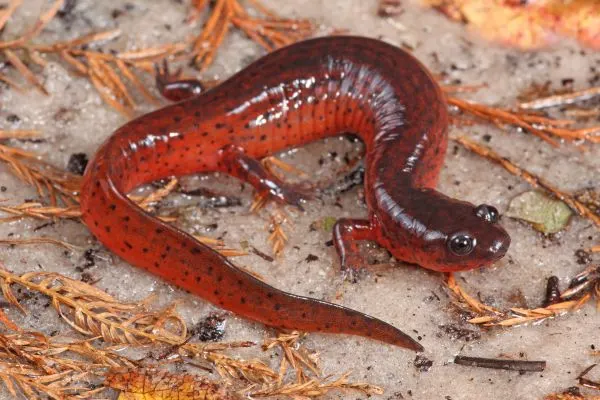
- Binomial Nomenclature: Pseudotriton montanus
- Adult Length: 2.95 to 6.30 inches (7.5 to 16 cm)
- Conservation Status: SNR
- Distribution in Louisiana: Southeast
The mud salamander is red in color. It is stocky in build and has a short tail.
Within Louisiana, the species is endemic to just the southeastern portion. The species is endemic from the Coastal Plains to central New Jersey, southern Pennsylvania, and Indiana. Within Florida, the species is endemic to the northern portion.
The species is endemic to marshes, backwater ponds, swamps along slow-moving streams, slow-moving floodplains streams, and muddy springs. Gravid females lay eggs on objects in slow-moving freshwater bodies.
Pseudotriton montanus is an opportunistic invertivore and feeds on earthworms, arthropods, and other invertebrates.
20. Red Salamander

- Binomial Nomenclature: Pseudotriton ruber
- Adult Length: 4.3 to 7.1 inches (11 to 18 cm)
- Lifespan: 20 years in captivity
- Conservation Status: SNR
- Distribution in Louisiana: Southeast
The red salamander is red in color and as such closely resembles the mud salamander. The red salamander has longer snouts and yellowish irises.
The red salamander is endemic to the Appalachian Mountains. The range of the species extends from New York to the Gulf Coast although the species is mostly absent from the Coastal Plains. Within Louisiana, the species is endemic to the southern portion. The occurrence within Louisiana is tiny.
The species are endemic to forested wetlands. They are found in cold clear rocky springs and streams of open and wooded areas. Adults generally hide under objects such as rocks and in burrows and crevices near freshwater.
The species is an invertivore and feeds on invertebrates. Sometimes, adults feed on small amphibians. Adults feed on land and larvae feed in water.
Family Sirenidae
21. Lesser Siren
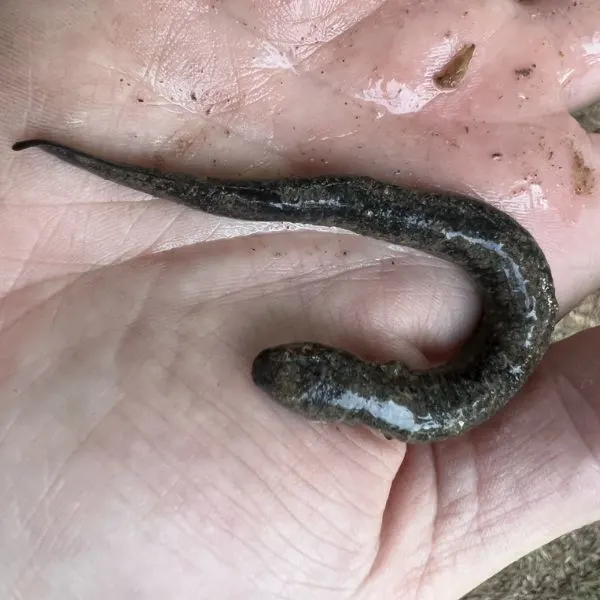
- Binomial Nomenclature: Siren intermedia
- Average Adult Length: 17 inches (43 cm)
- Lifespan: 6 years
- Conservation Status: S5
- Distribution in Louisiana: Statewid
The species is endemic to the southeastern United States and Tamaulipas and Veracruz in Mexico. Within Louisiana, the species is found statewide.
The species inhabit shallow warm waters with a lot of vegetation. This species is aquatic and only lives in freshwater. The siren is eel-like although it still has limbs.
The habitats the species live in include streams, rivers, lakes, ponds, sloughs, swamps and even ditches. Within its habitat, it remains hidden among vegetation and burrows in mud when the water dries up.
The lesser siren is predominantly invertivore and generally feeds on aquatic invertebrates such as mollusks, worms, and crayfish. Lesser sirens also eat plant matter and amphibian eggs.
Family Proteidae
22. Gulf Coast Waterdog

- Scientific Name: Necturus beyeri
- Adult Size: 6 to 8.5 inches (15 to 22 cm)
- Conservation Status: S3
- Distribution in Louisiana: Central
This waterdog is dark brown with light brown and black markings. It also has red bushy gills.
The species is endemic to the Gulf Coast drainage in the southwestern United States from Texas to the Mobile Bay drainage in Alabama. This includes west-central Louisiana – Calcasieu.
The species inhabit spring-fed streams with sandy bottoms. The waterdog lives at the bottom of its habitat. Waterdogs in Louisiana are associated with lead litter deposits in streams.
23. Red River Mudpuppy
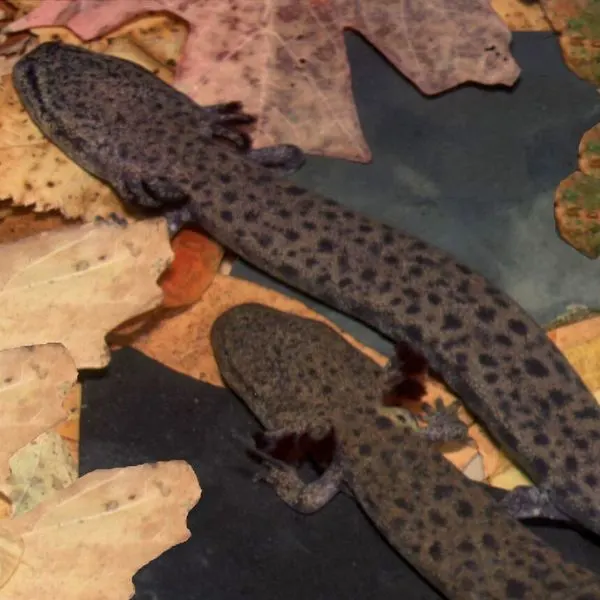
- Binomial Nomenclature: Necturus louisianensis
- Conservation Status: S3
The Red River mudpuppy is associated with the Red River. The species is endemic to northern Louisiana. Outside of the state, it is also endemic to southeastern Kansas, southern Missouri, eastern Oklahoma, and Arkansas.
Family Salamandridae
24. Eastern Newt
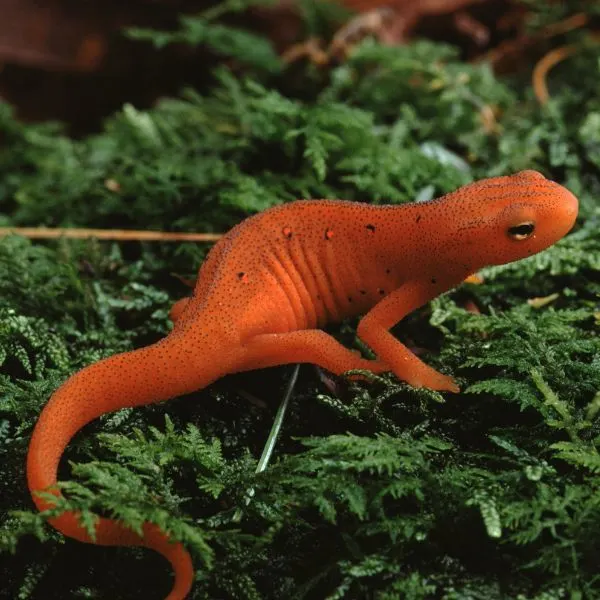
- Binomial Nomenclature: Notophthalmus viridescens
- Adult Length: 2.8 to 4.9 inches (7 to 12.4 cm)
- Lifespan: 12 to 15 years
- Conservation Status: S5
- Distribution in Louisiana: Statewide
The eastern newt is endemic to eastern North America from southeast Canada to eastern Texas. The geographic range extends to Minnesota to the west. The range also extends to the east coast.
The larvae and adults of the species are aquatic and inhabit slow-moving stream pools, swamps, and ponds. They may bury themselves in the muddy substrates when the pond dries up. Efts which are in the intermediate stage of the newt are terrestrial and inhabit woodlands. The intermediate eft stage lasts for two to seven years.
The aquatic larvae have olive skin and are tiny – 7 to 9 mm. Aquatic adults are greenish brown or yellowish brown.
Frequently Asked Questions
What kind of salamanders are in Louisiana?
There are 25 different kinds of salamanders in Louisiana. These salamanders fall under the following families – Ambystomatidae, Amphiumidae, Plethodontidae, Proteidae, Salamandridae, and Sirenidae.
Ambystomatidae includes mole salamanders such as the spotted salamander and the tiger salamander.
Amphiumidae includes amphiuma which are eel-like salamanders with just tiny limbs. There are two amphiumas in Louisiana.
Plethodontidae includes lungless salamanders. These are salamanders that respire through their skin and mouth. Examples of these are dusky and slimy salamanders.
Proteidae includes mudpuppies and waterdogs. The Gulf Coast waterdog and the mudpuppy are both endemic to Louisiana.
Salamandridae includes newts such as the eastern newt which is endemic to the state.
Sirenidae includes sirens. The lesser siren is endemic to the state.
How poisonous is a salamander?
Most salamanders are mildly toxic and don’t cause much harm to humans. They generally taste bad. This is a defense mechanism against potential predators. There are some salamanders that are highly toxic and these are the efts specifically, the eft stage of the eastern newt. The toxicity of the eft is marked by its bright red color.
Are there salamanders in Louisiana?
There are several salamanders in Louisiana. These can be found throughout the state.
What does a salamander look like in Louisiana?
There are many several kinds of salamanders in Louisiana. They all look different. Mole salamanders are stout. Lungless salamanders are slender and long.
Sirens and amphiumas are eel-like although sirens have just two limbs. Newts resemble mole salamanders a bit but are greenish-yellow to brownish. The eft form resembles bright orangish red lizards.
Conclusion
There are several salamanders in Louisiana. In fact, there are 25 of them. These include mole salamanders, lungless salamanders, amphiumas, mudpuppies, waterdogs, newts, and sirens.
These salamanders can be terrestrial, semi-terrestrial, and aquatic. Some aquatic salamanders endemic to the state include lesser sirens, mudpuppies, and waterdogs. Some semi-terrestrial salamanders endemic to the state include duskies. Some terrestrial salamanders within the state are the Louisiana slimy salamanders.
The red eft, which is the terrestrial stage of the eastern newt, is highly toxic. It is easy to distinguish from other salamanders within the state as it has a bright orangish-red color. While other salamanders may be toxic, this is mild. Regardless, it is unwise to handle wild salamanders.
Other nearby states
